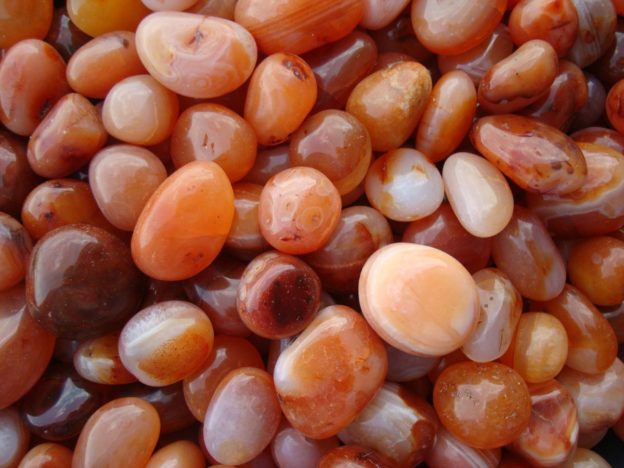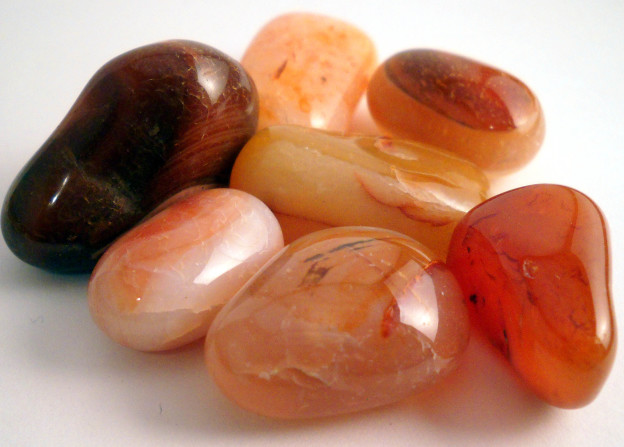Carnelian frequently accompanies emerald, turquoise and lapis lazuli in ancient Egypt. This blood-red stone, the color of the rising and setting sun, symbolizes the terrestrial life and the passage in the other world. It also represents the disk of solar gods that will become the halo of new religions. This sacred emblem crowns the god Re, Isis and his falcon-headed son Horus, Uræus the female cobra, and Hathor the horned goddess. A great example is the Tutankhamen breastplate exhibited at the Cairo Museum.
Cornalines must be bright and vibrant. In the 18th century, the great naturalist Buffon writes:
Mineralogical characteristics of carnelian
Carnelian belongs to the family of chalcedonies such as agates, jasper, onyx, sardoine, heliotrope or chrysoprase. This quartz, often brightly colored, consists mainly of silica and aluminum oxide. In the vast group of silicates they belong, by their architectural structure, to the sub-group of tectosilicates. These represent more than half of the mineral kingdom of the earth’s crust.
Carnelian is usually formed at low temperatures in volcanic rock cavities. Mainly composed of micro-crystals agglomerated in rounded masses, one can also observe it in the form of veining traversing other crystals. It holds its red color of iron oxide. The intensity of the hue may vary from red blood, the most esteemed, to russet orange.
Confusions and Possible Frauds
The confusion with sardoine is very frequent because it is very similar to him. However, sardoine (or Sardinian) shows a less translucent appearance and especially a browner coloring. Carnelian pulp is also finer than that of agates and does not usually have pronounced zoning. This united aspect also differentiates it from jasper.
For a long time, it is known to accentuate the hue of cornalines by heating, even by a simple exposure to the sun. A heat treatment “embellisher”, commonly allows more common agates to pass for cornalines the real red cornalines of good quality become rare.
Provenances of the Carnelian
The most famous cornalines come from India, mainly from the region of Pune. Other extraction sites are found in Brazil, Peru, Uruguay, the United States (in Washington State), Mali, Scotland, Iceland and Romania.
Etymology of the word “Carnelian”
The traditional explanation is that the carnelian would take its name from the reddish fruit of the dogwood, the cornel. This shrub, of the plant family of the cornaceae, grows in the natural state at the edge of the forests and in the hedges of the eastern Mediterranean countries. The Latin origin of dogwood and dogwood is corneolus (“appearance of the horn”) in reference to the hardness of its core.
A less frequent but probably more accurate interpretation indicates that carnelian comes from carneolus (appearance of the flesh) referring to its light red hue. Our carnelian would then belong to the same family as carnation and other predator and carnivore. The word would have been improperly transcribed corneolus . The Romans mean indifferently carnelian and sardoine of the same name sardus or sarda .
The word carnelian probably originated in the middle Ages. At that time, the language used by scholars was Medieval Latin, an altered form of classical Latin. The corneolus form is most often found in ancient lapidaries, and the Frenchized forms become corneol and then corneline . The inventory of John, Duke of Berry, evokes “two grants cornalynes “. From the sixteenth century, the carnelian takes its current form.
It should be noted that large glass balls, beautifully called “agates” in old playgrounds, become “cornalines” in French-speaking Switzerland.
Wholesale Healing Crystals & Stone Suppliers
The Carnelian throughout History
The Carnelian in Antiquity
The earliest concrete testimonies come from Mesopotamia. They date back to around 2700 BC the remains of Queen Pu-abi were found in the tombs of the ancient city of Ur. She wears countless necklaces and a gold lapis lazuli and carnelian headdress (see illustration below from the Pennsylvania Museum of Archeology, USA).
Excavations at a nearby tomb have revealed a kind of little chest, known as Ur’s Standard. Decorated with friezes of warlike adventures, we see characters and horses made of ivory and mother-of-pearl enhanced with Indian red carnelian. It is visible at the British Museum in London.
The Cabinet des Medailles in Paris has a tiny carnelian from the ancient Cretan Minoan civilization. Dating from the second millennium BC, this intaglio, engraved with great dexterity, represents an eagle removing a heron.
In Egypt, the carnelian protects the pharaoh and the solar gods. We find this sacred stone frequently enshrined in royal ornaments.
The Musée de l’Antique in Arles has a jewel representing this trend, in the form of a ram-headed hawk covered with a cloisonne of multicolored precious stones. The red feathers are made of carnelian. This fabulous bird dates from 1550 BC. Auguste Mariette discovered it in the 19th century during excavations at the tombs of the sacred bulls of Saqqara.
Egyptian lithotherapy also uses carnelian for curative purposes which does not seem the case of the Greeks and Romans. It is however one of the most appreciated stones. The sardines should preferably have a bright, intense red like the flesh, without any haze or unsightly filaments.
Pliny the Elder reports that the purest cornalines have “a figure of heart “. These are male stones from the quarries of ancient Babylon already in ruins in the 1st century AD. It also comes from India, Ceylon, Arabia and Paros and Assos in Greece. These, described as females, often have “tones of honey or terra cotta” much less esteemed.
The Romans place under the carnelian a little dull, a thin sheet of gold or silver to enhance their color as is still practiced today. Besides, the manufacture of jewelry and various small objects, the fine material of the carnelian allows beautiful achievements of colored cameos. It is also used for the intaglio engraving of stamps and “annulus signatorius “(rings to be signed).
The Carnelian in the middle Ages
The West of the middle Ages knows and uses carnelian. Bishop Marbode evokes it from the eleventh century: “The horn is stone oscure (obscure), grant virtue has its nature “. Medieval lithotherapy recognizes him with pleasant qualities:
The carnelian, red as the heart, transmits courage on the battlefield. The heart (the cuer ) symbolizes the courage and the virtues warriors, hence the expressions: “heart to the work”, “high hearts” … Logically, it also evokes the color of the blood, and it is recommended to stop haemorrhages of all kinds.
In the East, its tonic and astringent properties are commonly used. The Chinese exploit another quality of carnelian: its resistance to the heat of the oven. They mix carnelian powder called “ma-nao “with copper oxide to obtain a powerful red for enameling fine porcelain.
The carnelian in the Renaissance
Two types of carnelian are described: one bright red, called “old rock”, comes from the Orient. The other, more ordinary, “cinnabar red”, is commonly found in Germany near the Rhine or in Italy. A scholar, Anselme Boethius Boot distinguishes a third species, very pale, yellow-orange. This Flemish doctor also specifies the indications of carnelian:
Renaissance artists engrave carnelian with great skill. The Cabinet of Medals retains the famous “seal of Michelangelo” that would have belonged to the artist before joining the collection of kings of France.
It is a carnelian of 3, 5 x 2,5cm reproducing intaglio, a scene of finely detailed harvest, populated with fifteen characters and various animals. It has long been thought, as the Egyptologist Auguste Mariette, that this perfectly executed work, dated back to antiquity. In fact, it would be a friend of Michelangelo who would have realized: The famous engraver Pier-Maria de Pescia.
The cathedral of Reims holds a very different treasure, but with the course and history equally interesting. It is the nave of St. Ursula, ship of gold and silver, decorated with carnelian of Japan.
Its history begins in 1500, when the city of Tours offers it to Anne of Brittany. Later, the queen makes it an object of devotion by adding twelve small statuettes: a gold statuette representing St. Ursula and eleven statuettes of holy virgins enamelled silver.
The nave then belonged to Queen Claude of France, then to Henry II, who had it repaired. In 1574, Henry III offers it to the cathedral of Reims on the occasion of his coronation. The nave of Saint Ursula is visible today at the Palais du Tau located near the cathedral.
Wholesale Healing Sticks & Healing Wands Suppliers From India
The Carnelian in Modern Times
Thanks to the expansion of trade, carnelian loses some of its rarity in Western countries. From the seventeenth century, the famous stones, “old rocks” arrive in large numbers thanks to the VOC, the Dutch maritime trade. They come primarily from Japan where they usually undergo a treatment to enhance their color. These cornalines are frequently exchanged for German agates called “Oberstein”. Multicolored and often herborised, the Chinese particularly appreciate them.
The carnelian becomes a semi-precious stone, very appreciated in goldsmith’s art and for the creation of small objects of decorative or useful objects such as snuffboxes. The pale, yellowish carnelian is always discarded. Edme-François de Gersaint, a merchant of art and natural curiosities in Paris, wrote in the 18th century that carnelian must present a “bright red color of freshly cut flesh”. For the Swedish mineralogist Wallerius, the beautiful carnelian is “like the serosity of the blood”.
Some scholars, however, are interested in imperfect coralines : stained, milky, or crossed irregularities. Jean-Christian Kundmann, doctor-naturalist and antiquary gives the name of “stone of Saint-Etienne” to a whitish carnelian spotted with blood red.
Louis Daubenton, the first director of the National Museum of Natural History, describes a carnelian-onyx, a winged carnelian and a carnelian carnelian. The latter says he is more beautiful and more esteemed than the simple agate of the same name because “its vibrant colors of several shades of red form a delightful picture of small flowering mosses “. At the same time, we discover, on limestone hills near Le Havre, some curious samples of carnelian alternated with chalcedonies “water color”.
In the gallery of coaches of the Palace of Versailles, one can admire a sumptuous sedan with four windows and inside padded with ivory satin. Named “Carnelian”, it is used for the wedding of Napoleon I with Marie-Louise. She accompanies other ceremonial cars with precious names: Amethyst, Turquoise and Topaz.
Napoleon also has real cornalines. The museum of the Army to the Invalides exposes a small gusset lorgnette made of carnelian, suspended with a chain of gold. The emperor uses this miniature telescope in all his military campaigns.
The Virtues of the Carnelian in Lithotherapy
The carnelian symbolizes blood and vitality. It has always been given positive and protective effects, especially for women, children and the elderly.
The Benefits of Carnelian against Physical Aches
- Stop bleeding (of all origins)
- Activates the healing of wounds
- Relieves rheumatism, osteoarthritis
- Calm neuralgia, low back pain
- Strengthens the circulatory system, the heart
- Purifies the blood, protects the kidneys
- Relieves stomachaches: colic, colitis, painful menstruation
- Facilitates digestion and intestinal transit
- Promotes sexual fulfillment (impotence fight, frigidity)
- Improves fertility
- Strengthens bones and ligaments
The Benefits of Carnelian on Psychism and Relational
- Restores vitality and energy
- Transmits the love of life
- Removes the fear of death
- Fight against apathetic, depressive states
- Promotes resolution, success
- Facilitates adaptation to new situations
- Stimulates concentration and meditation
- Strengthens the memory
- Give confidence to the shy
- Encourages speaking skills and stimulates speech
- Increases resistance to adversity, abuse
- Soothes anger, resentment and jealousy
- Maintains and stimulates creativity
- Protects the house
Carnelian essentially activates the root, sacred and solar plexus chakras (in direct contact with the skin). It can be used as a tonic and detoxifying elixir.


